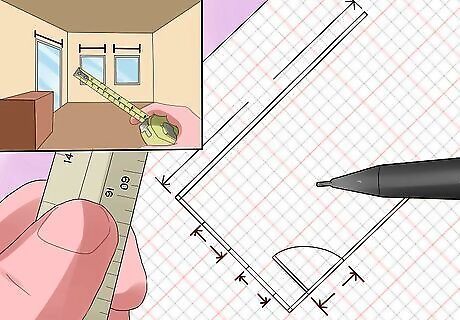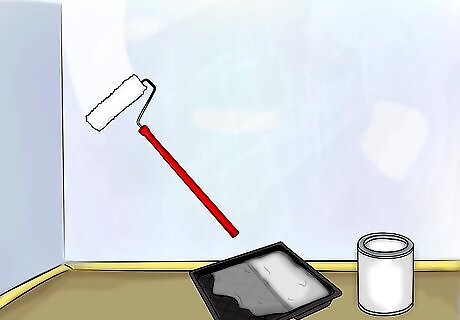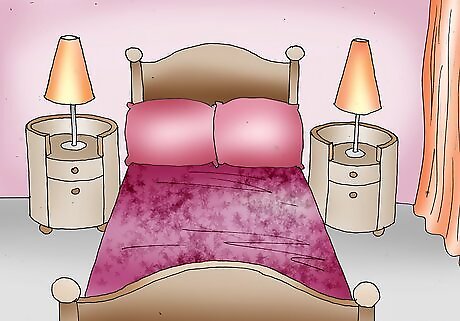
views
Creating a Design Plan

Make a mood board. Before you start moving anything around in the room, you should put together a mood board or an inspiration board. A mood board can be a collection of images from different sources, such as magazines, the internet, or even hand drawn sketches, that inspire you. You may structure the mood board around a theme, such as “punk rock” or around a certain color scheme or pattern. A mood board can be a great way to get inspired and form a clear sense of the style of the room. It may be helpful to also look online at design blogs that showcase teen bedrooms and style ideas. You may find a certain look or style based on images of existing bedrooms or a combination of two different approaches. Try to integrate your hobbies and interests into the design of the room. If you are into a certain sport, like skateboarding for example, you may try to include skateboard images in the room. If your favorite color is blue, you may include different shades of blue in the room. It's important that you and your parents agree on the overall style of the room and have a unified sense of how the room will look. Though your parents may be helping you to transform the room, you will ultimately need to live in it and you should have a major say in the design choices for the room.

Draw a floorplan of the room. Once you have decided on a theme or a certain style for the room, you should draw a rough floorplan of how you would like to rearrange the room. This could be a rough sketch of where key items, like the bed, the desk and the bureau are going to be placed in the room. You should also consider if there is enough storage in the floorplan for your clothing, your personal items, and your school books, and that there is a designated work space, especially if you tend to do your homework in your room. Making a floorplan can also help you get a better sense of how to best utilize the space, such as ensuring the bed is in a spot that gets lots of sunlight or the desk is in a spot where there are limited distractions or close to a window.

Consider wall color options. One of the biggest design choices you will make is paint wall colors, as paint can make a big statement in a room. Use paint swatches from your local paint store to decide what colors may look good in the room or fit with your theme. Make sure you try out the colors on the wall before you buy enough for the entire room to avoid choosing the wrong color. If you are trying to create a relaxing space, you may suggest neutral tones like white, gray, or beige. You can then add pops of color with accessories and furniture. If you're going for a more bold look, you may want to consider interesting contrast colors like yellow and black or red and gray. If your are into art and drawing, you may create a blackboard wall in the room, where one wall is painted with blackboard paint that can be drawn on with chalk.

Think about lighting options. Another big design element is lighting, as lighting can make a big impact in a room. Maybe you prefer ambient lighting in the form of cafe lights or an overhead light with a dimmer option. You may also decide to include a desk lamp if you tend to study or read in your room and do not want to have to strain your eyes.

Decide which furniture to keep and which furniture to replace. Go through the furniture in your room and consider what you'd like to keep and what you'd like to sell or donate. Remember that you can update your existing furniture with fresh paint or new drawer knobs. Updating furniture can be a fun way to personalize your room. Once you decide which furniture you're keeping and which furniture you're replacing, you should arrange a donation run with your parents to get rid of the furniture you do not want or post the items online to try to sell them. You may also want to take a look around the rest of the house for other furniture or items that may fit in your new room. If there is a pile of old furniture in the attic or the basement, dig through it for any furniture that may suit your room makeover.
Painting and Furnishing the Room

Go shopping for new furniture and accessories. Based on your floorplan and your mood board, you should be able to make a list of all the new furniture items and accessories you need to buy for your new room. If you are on a budget, you may try to find certain items online or at garage sales. You may also go to discount furniture stores and shops that sell affordable accessories. Your shopping list may include big items like a bed or a desk, and accessories like new bedding, pillows, storage options like shelving, and frames for photographs or posters. You may want to enlist the help of a parent when you go shopping, especially if you do not drive and need to get around in a bigger car to pick up the necessary furniture and accessories.

Paint the walls. Once you've decided on your paint colors, you should prepare the room for painting. This means taking all the furniture out of the room so it is empty and the walls are easy to access. Cover any remaining furniture or items in the room with sheets so they do not get splashed with paint. You should then cover the corners and edges of the walls with painter paint so the paint only gets on the walls and not the ceilings, moldings, or the floor. Before you paint the walls with your chosen wall color(s), you will need to prime the walls with primer paint. Once the primer paint dries, you can apply one to two coats of your chosen wall colors. You may want to throw a paint party with a few friends and work on painting the walls together. Reward your helpers with pizza and your undying gratitude for helping to make the painting process go by much faster.

Add the lighting and the furniture to the room. Allow the wall paint to dry completely, usually overnight or a couple of days depending on how many coats of paint you have applied, and then move in the lighting and the furniture. String cafe lights along the ceiling if you decided on a more ambient look or set an overhead light on a timer. You should make sure you have a good desk lamp for when you do homework or read. As well, you should ask your parents or a friend to help you move your furniture into your room, including your bed, your desk, and your bureau. If you decided to replace your bedding so it's more age appropriate, you should switch out the bedding to see how it fits with the rest of the room. Make sure your storage options, such as wall shelving or storage lockers, also fit well in the room and are convenient for you to use. Usually, the more storage options you have in a room, the better.
Adding Personal Details to the Room

Make room for photographs of friends and family on the walls. Adding personal details like photographs, posters, and other visual mementos can really make your room feel special and unique to you. Consider hanging up photographs of friends and family in your room, or a picture of a person you admire or respect. You may also hang an inspirational saying or a funny quote that you love. You can frame and hang these pictures in simple frames on one wall to create a fun visual display or blow up on photograph to create a statement piece. Try to focus on images that have some meaning or value to you as you may be staring at them day in and day out.

Do small DIY projects to create personalized accessories. If you are looking to create personal touches on a budget, try a small DIY project like a terrarium or a fun project with washi tape. There are many DIY blogs online with lists of easy projects that you can do on a limited budget. Enlist the help of your friends or a parent and do a DIY project together. This can be a fun way to hang out and also create unique accessories for your new room.

Include sentimental or prized items. Though you may be tempted to throw away every item from childhood in your quest to have a teen appropriate room, consider saving certain sentimental or prized items like childhood medals or trophies. You may have an item given to you by a loved one that you treasure or an accessory gifted to you by a friend that you value for sentimental reasons. Including these unique items in your new room can make your room feel every more unique and specific to you.

Add one fun, unique element to the room. To really elevate your room make over, you may want to consider adding in one fun and interesting element to your room, such as paper lanterns, a great mural on one wall, or a cool vintage sign from a flea market. Statement pieces that are singular and special can really make your room feel more grown up but still interesting and particular to you. Avoid adding in too many unique elements in your room makeover, as too many big, fun statement pieces can make the room feel chaotic or overwhelming. Stick to one unique element so the room feels cozy and interesting, but not overdone or cluttered.
















Comments
0 comment